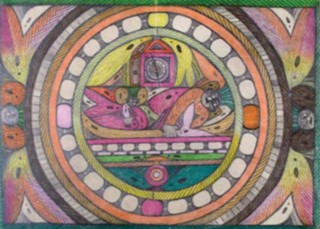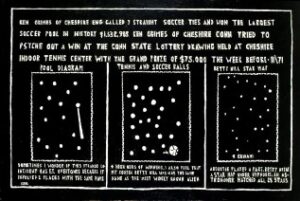
Five Outsider Artists at Intuit Gallery

Since his work was revealed to the public in the early seventies and rose to worldly acclaim shortly thereafter, Henry Darger has become the rule by which outsider art is measured. “Unreal Realms,” on view at Intuit Gallery, presents a selection of works by five artists, including Darger, and proposes that they are all united by their visions of alternate worlds.
The works in the exhibition are small and preserved under framed glass in low light to com- pensate for their poor archival quality. Each artist is given their own section of a wall in the rect- angular room so viewers can move easily from one artist to the next. The lack of integration of the works reinforces the idea that these artists worked in isolation.
The title “Unreal Realms” places value on the imaginary worlds these artists inhabited but the creativity in the curation stops there. Instead, we are presented with the artists in chronological order despite there being no evidence that this exhibition is about history.
The first artist in the chronology is Adolf Wölfli whose life and practice predates that of Darger. Their lives bear similarities. Both were orphaned in childhood and believed to have suffered physical and sexual abuse leading to lives of institutionalization and social rejection.
Though Wölfli’s drawings are less illustrative than Darger’s, they too are a product of an extensive autobiographical and fantastical narrative penned by the artist. Wölfli’s did not follow illustrative traditions but relied on pattern and ornamentation akin to art objects from pre-mod- ern practices like indigenous American totems or Bhuddist mandalas.
Continuing in this clockwise manner are works of a similar scale by Charles A. A. Delschau. An American also working in the late 19th century, Dellschau created images of elaborate aerial vehicles made up of cabins, propellers, and bal- loons. His work had a narrative basis that revolved around a secret club of flight enthusiasts. Some background research was done to see if this secret club actually existed but little evidence was found.

The precisely crafted architectural images by Achilles G. Rizzoli employ a different visual language. Rizzoli worked at an architecture firm so the work bears semblance to architectural illustrations. However, Rizzoli was also crafting a world based around an international expo- sitionstyle event he called ‘expeau’. What is striking about his work, as noted in the cura- tor’s description, is that his architectural drawings of buildings were actually symbolic portraits of friends and family. This is the strongest example of how significant a role symbolism plays in these artists’ works.
The only piece free from lexicon of the creatures that inhabited his unreal realm. A few of these drawings are titled with the name of the creature and where it comes from. The ‘Cat Headed Blengin’ and the ‘Young Gazonian Blengin’ hail from a place called the Catherine Isles. This display of Darger’s narrative work as well as the lexiconic element further suggests a privileging of Darger’s practice that is already obvious by the fact that the whole exhibition is directly referencing the first portion of his fiction- al work’s long title.
The last artist on the clockwise path is still living and the most aesthetically distinct. Ken Grimes’ works on larger panels, with only black and white paint, relies mostly on text to construct his narrative around his interests in coincidental phenomenon and extraterrestrial life. The wall text supports the artist’s claim that his use of black and white is representative of his invest- ment in the distinction of truth vs. deception. The most minimal of these works feel the most urgently persuasive.
Wölfli and Darger have a sense of dire need to tell the story of their worlds as well but are handled with more illustrative techniques than Grimes’ more didactic pieces which read more like sign boards.

The commonalities that are discussed in the wall texts pertain to the lives of the artists and the imaginary worlds they envisioned. There is little to be said about their processes, methods, and materials likely because, for the older artists, little of that information was known.
The dramatically formatted quotations floating above the works on the gallery walls speak to a valorization of the gifted madman archetype being celebrated here. The exhibition reads as a kind of voyeuristic look into the wall is one of Darger’s long scroll-like illustrations framed under glass with images visible on both sides. The piece Achilles G. Rizzoli Mr. and Mrs. Harold Healy Symbolically Sketched/First Prize, First Anniversary, 1936 minds of the artists that rein- force their outsider status.
This is perhaps Intuit’s goal, since their claim is to celebrate is untitled but its central placement in the gallery emphasizes that in this curation everything revolves around Darger. In addition to his images that depict events through populated landscapes, Darger created a “artists who demonstrate little influence from the mainstream art world.” However, this makes the assumption that there is a mainstream art world. There is potential in this exhibition for Intuit to put pressure on that idea instead of sustaining it.

First Anniversary, 1936
Evan Carter
Evan Carter hails from Worcester, Massachusetts. He studied Painting at Mass. College of Art in Boston and is currently an MFA candidate in the Department of Visual Art at the University of Chicago.
Volume 31 no 4 March / April 2017 pp 30 -31

